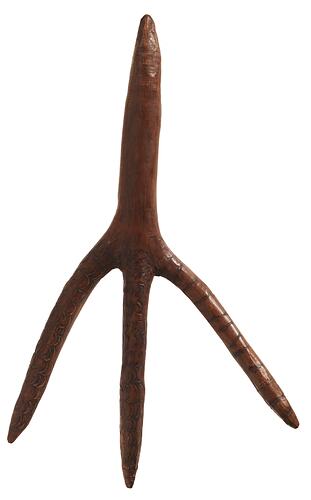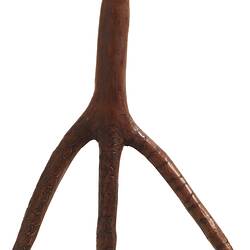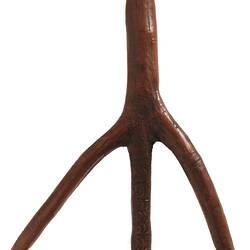Summary
This punu (woodwork carving) was made by a Pitjantjatjara/Yankunytjatjara person in the Amata community which is in the far Northwest of South Australia. Amata is part of 103,000 square kilometres known as the Anangu Pitjantjatjara Yankunytjatjara (APY) Lands. Regrettably the name of the Pitjantjatjara/Yankunytjatjara person who carved this kalaya punu (emu carving) was not recorded.
Kalaya (Emu) are a relatively rare sight in certain regions of Central Australia, although small flocks are recorded in a range of habitats, including sand dunes, spinifex sand plains, tussock grassland and the foothills of the ranges.
Anangu (people from the Central and Western deserts) track the distinctive tri-claw prints to hunt Kalaya at almost every opportunity, as their kuka (meat) is a special food favoured by the elderly. The emu kuka is carefully cut in particular pieces before being shared between at least four of five people.
From a very young age, Aboriginal children learn to recognise and imitate the tracks of animals. The sandy or loose soil makes a good drawing board on which the children learn the patterns and shapes representing common animals. Having learnt the prints of these animals, children are taught the skills required to provide for themselves and their future families by accompanying adults when they hunt the animals.
Local Name
Kalaya
Physical Description
Carved wooden Emu foot. The three front toes are decorated with markings which have been burnt into the surface. The design consists of straight lines separated by a number of short curved lines and dots. The surface of the wood appears to have been stained a reddish colour with ochre.
Significance
Aboriginal people of the central and western desert areas of Australia refer to themselves by the names of their dialects: the Pitjantjatjara, the Yankunytjatjara, the Ngaanyatjarra and the Ngaatjatjarra people. Anangu literally means person or human being in Pitjantjatjara and Yankunytjatjara. Anangu has come to be used as a collective noun in this area, just as people might be referred to as Koori or Murri in eastern Australia.
Contemporary carvings by Anangu (Central and Western Desert Aboriginal people) are known as punu, hand carved and decorated with patterns burnt into the wood. The animals all have their associations with the Tjukurpa, the stories of the Creation Ancestors and the activities which shaped the land, the people and the Law.
The many talented artists of the Amata Anangu community are represented by the artist-run Tjala Arts. Contemporary Anangu people celebrate their culture though art and Tjala Arts is known as the heart of the Amata community as three generations gather at this important art centre to celebrate their culture. Artworks by Tjala Arts are held in many of the State and National Art Institutions and museums across Australia and internationally. Tjala Arts artists embrace a variety of different media including painting, traditional punu (woodwork), Tjampi (sculptural fibre weaving), photography, film and sound.
Ray Ken, highly respected Pitjantjatjara/Yankunytjatjara Elder and renowned artist explains the importance of Art-making in the Anangu community;
"When we are resting, it will be the young fellas turn to look after our Country; this is the Anangu way. As they've been growing up, they've been learning how our stories can make you strong inside and to be strong is to keep culture safe - so that nothing can take it away. This Country will be theirs soon, they belong to it and they know how to stay here. Now I've seen young fellas in the art centre working and they are doing strong work and a good job. I am happy that they can take this, too."
Ray Ken 2015.
References
Tjala Arts, Our Art Centre, 2015, Viewed 23 August 2017.
http://tjalaarts.com.au/site/our-art-centre
More Information
-
Object/Medium
Animal figure
-
Maker
-
Cultural Groups
-
Locality
-
Date Produced
-
Collector
-
Date Collected
-
Object Measurements
420 mm (Length), 270 mm (Width), 50 mm (Height)
-
Classification
-
Date Made
-
Maker
-
Clan/Language Group
-
Place Made
-
Indigenous Region
-
Keywords
-
Collection Names
-
Type of item
-
Discipline
-
Category
-
Collecting Areas


